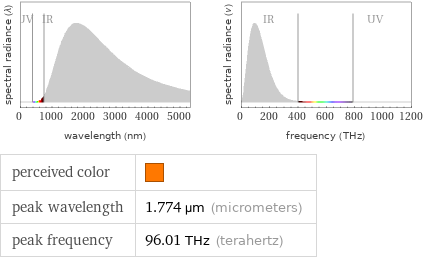Input interpretation

iron(II) oxide | melting point
Result

1360 °C (degrees Celsius)
Unit conversions

1633 K (kelvins)

2480 °F (degrees Fahrenheit)

2940 °R (degrees Rankine)

1088 °Ré (degrees Réaumur)

721.5 °Rø (degrees Rømer)
Comparisons as temperature

240 °C below temperature of a Bunsen burner flame (1870 K)

178 °C below melting point of iron (1538 °C)

40 °C below temperature in the blue part of a candle flame (1670 K)
Blackbody information

perceived color | peak wavelength | 1.774 µm (micrometers) peak frequency | 96.01 THz (terahertz)
Corresponding quantities

Thermodynamic energy E from E = kT: | 14 ceV (centielectronvolts)

Blackbody energy flux Φ from Φ = σT^4: | 403382 W/m^2 (watts per square meter)

Approximate luminous exitance from a planar blackbody radiator perpendicular to its surface: | 91590 lx (lux)